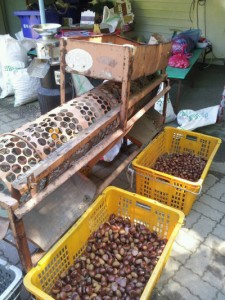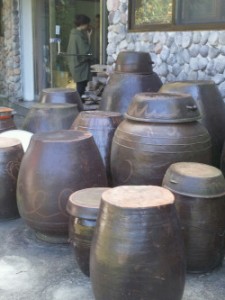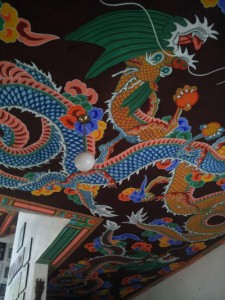5 October 2013
 Today we went on a teacher’s outing to Gongju, with some of the Asan Board of Education public school teachers. It really was an interesting look into some of the ‘rural’ traditions and the cultural legacy that still lives on in South Korea.
Today we went on a teacher’s outing to Gongju, with some of the Asan Board of Education public school teachers. It really was an interesting look into some of the ‘rural’ traditions and the cultural legacy that still lives on in South Korea.
Hunting for Chestnuts
The first task was a thorough chestnut collection, which was actually a lot more fun than it sounded on the itinerary. Chestnuts (밤 ‘bahm’) are traditionally eaten roasted, or peeled and frozen to be eaten raw.

We were shown how to break open the spiky pod and extract the shiny brown chestnuts with tongs. Armed only with tongs and an orange net bag, we were led up the steep pathways and sides of hills to tackle the chestnut plantations.
Aside from minor injuries from chestnut pod spikes, the other exciting event of the morning was finding a small brown snake on the grassy bank (Google later revealed it was a ‘rat snake’ of some sort), which a brave Australian soul rescued from certain death, by flinging it as far into the bush as possible, away from the Korean tour guide.
We headed back with orange bags overflowing with chestnuts and enjoyed some roasted and frozen, raw chestnuts as a reward for our efforts.
Traditional Korean lunch
We then headed down the road to a traditional folk museum, restaurant and chestnut dyeing complex. It has been run by the same family for the last 200 years, who still live, farm and dye with chestnuts (no pun intended), in the same farming area in Gongju.
Treated to a traditional Korean lunch, we experienced lotus steamed rice (covered in lotus leaf, with

herbs), an array of unique Banchan (side dishes) special to the Gongju region, makgeolli (rice wine) and mushroom water (like ice tea, but made from mushroom juices); all this served in the traditional low Korean tables, sitting on flat cushions on the wooden floor, with legs folded under us.
Since the restaurant and surrounds were all things chestnut, chestnuts appeared as an ingredient in the vast majority of the dishes served. Even the servers clothes and restaurant furnishings were dyed with chestnuts.
Traditional Folk Art Museum
The ‘chestnut’ family has also collected artifacts from the neighbouring farmers over many years, as well as the collection of dramatic art pieces used by the current owner’s father, who was a well-loved traditional Korean puppeteer in his spare time. It includes farm implements, cultural pieces, masks, paintings, shamanistic symbolism, farm life cooking tools and many other interesting things to see and experience.

My highlight was seeing an actual South Korean funeral carrier, a colourfully decorated box that traditionally holds the coffin and is carried to the burial mound by about 12 men. These days, it is rare to see one in use as, our host joked that, Koreans are now taller than in the past and so don’t fit in the carrier very well. The carrier at the museum was retired only a couple of years ago.
The next week at school, I was surprised and very privileged to see one of these coffin carriers actually in use, as a funeral procession passed the school and headed down the road; singing, clapping and mourning the loss of a 75-year old lady that had lived in this community.
Chestnut Dye
The last activity of the day was a handkerchief dyeing lesson. We were shown the crushed chestnut husks that are used to make the dye and different ways to tie-dye our handkerchiefs. We dipped it in the hot dye (hands and arms covered in rubber gloves) and took turns to “massage” the dye into the handkerchiefs in the pot. Then out into the cold solution that sets the colour. This process was repeated two or three times; ending with a cold water rinse and then handkerchiefs were hung out dry.
Mine was sadly unremarkable, as it was lost in the dye pot for a while and lost all its strings, but a few of the other teachers managed to produce some seriously impressive dye patterns.
Take a trip
If you are headed to Gongju, you can find more information about the museum and the area at this link. It’s a great day trip for those interested in learning a little more about traditional Korean life.

